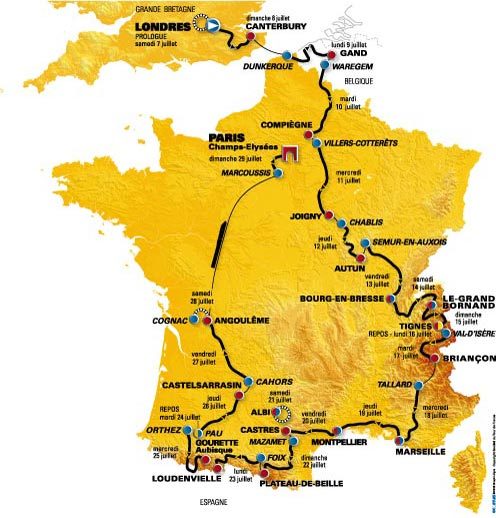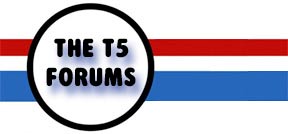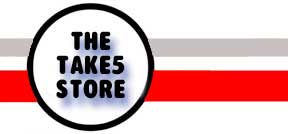Tour de France 2007: How to Watch

The Tour de France can be a little puzzling to first time observers.
There are stages where the leader/leaders nonchalantly let others ride past them without a care in the world and other stages where they fight tooth and nail to chase down another pack and then take it easy …
Basically, the winner is the person with the shortest recorded time from Day 1 to Day 20 (with some rest days in between). The winner is the person with the shortest cumulative time after 3553.9 km.
While technically, everyone has a shot and everyone’s time is counted – the person who wins has to have two skills. They need to be able to ride away from other people on mountains on a daily and consistent basis AND they need to be able to go fast during the individual time trials because those are essentially the only two places to actually gain time or catch up on others. Out of the typical 180 or so riders who start, here are probably only 20 riders who can actually ride away from other riders on the mountains on a consistent basis so basically that is the GC (General Classifications) group of possible winners. Then to separate yourself from those 20, you need to be able to ride fast in an individual time trial stage.
Basically, each day is a stage with 20 in total over 22-23 days (there are rest days – usually after mountain stages). The course changes from year to year and can ride into any of the countries bordering France. They will always end in Paris.
The leader of the GC wears the fabled yellow jersey.
He is accorded special respect, if he happens to be in an accident or caught behind a huge accident, if anyone is way out ahead of him – they will slow so when the yellow jersey is back up to speed, the time gap is approximately the same. There is a funny story of a guy who decided not to respect the yellow jersey rider by waiting. Other riders retaliated – when the idiot took a bathroom break, they stole and hid his bike.
Speaking of bathroom breaks, during long stages, the yellow jersey guy decides when they will take a bathroom break.
TACTICS
Like auto racing, there are hidden penalties in racing out to the front – you expend much more energy “breaking” the wind than you would drafting behind someone and then swinging out to pass them at the right place.
The Tour de France usually starts out with relatively flat stages so a few lesser riders will race out and try to win an individual day (aka – stages). Lesser riders are generally anyone not expected to be competitive once they get to the mountain stages or others know they are slow on the individual time trials. So, their only shot at glory is to win a stage and they are not strong enough to sprint away from a pack at the end so they have to strike early. For instance, some days are over 200km or @120 miles but after 10 miles or so, some guy will sprint ahead – once they determine who it is – presumably, it’s a no-name racer just hoping to win a stage, most of the racers won’t care and just let him go but in most stages, randomly, people will launch “attacks” to see if they too can “get away.” (they essentially pedal as fast as they can and see if others or the group react). If they do get distance between them & the pack, that is called a “breakaway.” There can be several breakaways as later on, others ‘breakaway’ to catch the first breakaway. The largest pack is called the “pelaton” though in mountain stages, there usually are anywhere from 5 to 10 groups so the “pelaton” label is not as easy to spot.
This is a classic picture of the swarm-like look & feel of a pelaton:

For instance, one year, a guy raced like crazy in an early stage and managed to get like a 10-minute lead on Lance Armstrong – hoping that Lance was weaker in the mountains that year and that he could hold off Lance in the mountains by losing to him by less than the 10-minute lead he gained in the beginning flat stages … it didn’t work by the way, it pretty much took Lance a day to catch him in the mountains.
One reason they let some guys go is that it’s much harder to ride by yourself – psychologically and wind resistance wise and the bigger the group, the faster they can gain on a solo rider – in wind tunnel tests, riders in giant packs going at the same speed as an individual rider use about 70% of the energy so in many cases, a guy in a breakaway can go all out for 170 km but be caught by the last 20 km.
If someone GC “capable” tries to sneak off, teams will form a pocket around their lead GC guy and chase down the guy so it’s pretty pointless because the first real test is the mountain stages anyway – if you can’t cut it there and ride away from others, there’s really no lead safe in early flat stages.
But even if you know you will fade in a few days, why not get TV time & glory for a day by giving it your all – people understand if after you fade to 120th in a few days. You got TV time and you got to wear the yellow jersey … especially if you’re French, Belgium or European.
As they reach the mountains, teams with strong GC contenders will try and help their guy by pacing him up the mountain. Like rabbits in long distance track races, they will try and set a pace that eliminates others while giving a psychological boost to their GC rider since he’s right behind. At some point, he will give out and peel away to let their lead GC guy take over the rest on the way to the mountain summit (Most mountain stages end at the summit but not always). A super strong team like Discovery when Lance was riding might have 2-3 guys who can pace Lance up the mountain on alternate days before peeling away.
Then after the first mountain stages, there is generally a few more flat stages so the yellow jersey might change hands – no point in wasting energy trying to stay in front with more mountains ahead. Again, if some guy they know cannot race fast in the mountains sprints away on a flat stage, they might just let him go or while letting him win the stage, try and keep the time gap loss to a minimum. Generally though, by the end of the first day or the second days at the next/last set of mountains stages, the eventually winner should stake their claim there.
To re-enforce the time advantage, there is an individual time trial (or two this year) where riders get on their $40,000 bikes made as light as possible with aerodynamic non-spoke wheels (though dangerous during windy days), wear the teardrop helmets – are staggered started at 5 minute intervals (in order of current standings) and timed. Basically to win the Tour de France – even as a great mountain stage rider, you pretty much have to be in the top 5 of the 180 riders (though with dropouts, by the time trials, there is probably only 160 riders). That’s why Lance was hard to beat. He was the best mountain stage rider and if not the fastest time trialer, he was no more than a few seconds off in 2nd. Some great riders lose HUGE time in these time trials.
This year like the last few years, the time trial is the day before the last day so it’s make or break that day. So unless there is only a few seconds difference. the race essentially ends before the final Paris stage … because also … It is bad form to try and race away on the last day in Paris. It’s more of a ceremonial day except for the sprint in the final hundred yards for the sprinters.
Speaking of which, that is the other speciality. There are sprinters. The best sprinter (points and wins) gets to wears a green jersey as the best sprinter. There are teams built just to win sprinter points and stages which end in a sprint. So, these teams will try and reel in any breakaway riders before they come to that day’s finish line so their sprinter has a chance to win or at least get some points. It’s an amazing site to behold. These guys after riding for 100 to 200 km will suddenly find the strength to get to 50 MPH+ and literally sprint to the finish.
Generally only mountain stages (and of course time trials) do not end in sprints. It should be noted that sprinters are generally not among the top 10 in the time trials as they have the quick twitch muscle and cannot go at the best speed for 100 km.
POINTS
Just to make it more interesting, randomly during each stage, there are artificial lines drawn throughout the race – usually no more than 4 where points can be earned so sometimes you’ll notice the sprinters jostling for position in the middle of a long stage – because they want to get points for crossing that line 1st, 2nd or 3rd. It’s not a lot of points but the leader gets to wear the green jersey.
Of course, there is prize money for the top 3 in CG, points, sprints and “King of the Mountain (polka dot jersey).” In the middle of mountain stages, there are also lines with points. There is also a rookie points race and a team points race but most people focus on the yellow jersey and the GC. For instance, even though Lance Armstrong was really the king of the mountain, he did not win that designation because he did not jostle for the points in the middle of mountain stage races by trying to cross a line 1st, 2nd or 3rd and in many cases, he didn’t even win that many mountain stages – just enough to have the lowest time. I think his final year, he only won like 4 out of 20 stages.
TIME KEPT
Note, when you finish 1st, 2nd or 3rd, you also get “bonus time’ erased from your overall time so for the leading riders, if they win a few stages, their final time is not their actual real time – but usually off by no more than a minute or so … and after 20 days and 3,500 km, who’s counting that closely?
Also note, when you come in a tight packed group, you get the time of the first guy who crosses in your group – since it’d be confusing and pointless to try and time 50 riders who come in slowly together who are not sprinting to the finish.
You can read more at Wikipedia. It’s an interesting and fun race to watch as most of France seems to turn out. Hopefully, they can put the blood doping thing behind them.
Of course you can get race results on your iPhone 🙂






